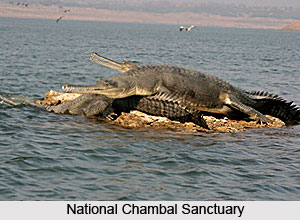 The National Chambal Sanctuary in U.P. covers an area of 635 sq. kms spread over the Agra and Etawah districts. It was formed to protect the pristine river ecosystem of Chambal River, complete with its varied flora and avifauna. The Chambal River which is the mainstay for the entire wildlife of the sanctuary harbours a variety of aquatic life like the elusive Ganges River Dolphin, Freshwater Turtles, Gharial (Gavelia Gangeticus), Crocodile (Muggar), River Otters and a number of species of fishes. All these wild inhabitants can be easily seen by tourists within the sanctuary area, especially in the middle reaches in the downside of Rajghat Bridge on the National Highway number three.
The National Chambal Sanctuary in U.P. covers an area of 635 sq. kms spread over the Agra and Etawah districts. It was formed to protect the pristine river ecosystem of Chambal River, complete with its varied flora and avifauna. The Chambal River which is the mainstay for the entire wildlife of the sanctuary harbours a variety of aquatic life like the elusive Ganges River Dolphin, Freshwater Turtles, Gharial (Gavelia Gangeticus), Crocodile (Muggar), River Otters and a number of species of fishes. All these wild inhabitants can be easily seen by tourists within the sanctuary area, especially in the middle reaches in the downside of Rajghat Bridge on the National Highway number three.
The Crocodile Centre is the only one of its kind in the entire state and has recently been opened to public. The centre helps breed and rehabilitate crocodiles and gharials in the Chambal Sanctuary. The Chambal River boasts of a population of over 200 crocodiles and 1600 gharials. The rare Ganges River Dolphin (Platanista Gangetica), the sole member of the Cetaceans group is one of the most prominent attractions of the sanctuary. Famously called the queen of Chambal, the Dolphins inspite of being blind can be seen pursuing their playful antics in the water while coming out to breathe for air. The Chambal sanctuary is one of their safest breeding areas.
The surrounding environments of the Chambal River are a true bird watchers delight. During the season, from November to March, one can enjoy the sight of thousands of migratory and resident birds flocking at the shores of the river. At least 150 species of birds have been identified at this place. Species of birds in abundance are the Bar-headed Geese, Flamingoes, Common Teal, Brahmini Duck, Pelicans and Cormorants. Tourists can enjoy the sight of the Indian Skimmer-the highest population of which in the world is found in Chambal. There is motor boat facility for tourists in the National Chambal Sanctuary and one can enjoy various beautiful sites in this sanctuary by availing a motor boat. Complete safety within the peripheries of the sanctuary is ensured by the local authorities. One can enjoy the natural wonders of the sanctuary which during the 50`s and 60`s was largely hidden due to the presence of dacoits.



















